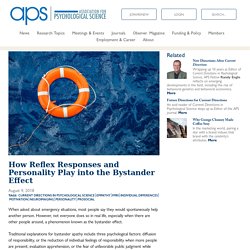

This resource collection covers how we can counteract the bystander effect. The tragic case of Kitty Genovese that sparked the bystander effect phenomena. The Kitty Genovese murder in Queens, New York, in 1964 is one of the most famous murder cases to come out of New York City and into the national spotlight.

What propelled it wasn’t the crime or the investigation, but the press coverage that alleged the murder had many witnesses who refused to come to the Kitty Genovese’s defense. This has been disproved over time, but not before it became part of the accepted lore of the crime. Kitty Genovese was returning from work home at around 2:30 a.m. on March 13, 1964, when she was approached by a man with a knife. Genovese ran toward her apartment building front door, and the man grabbed her and stabbed her while she screamed. A neighbor, Robert Mozer, yelled out his window, “Let that girl alone!” Genovese, seriously injured, crawled to the rear of her apartment building, out of the view of any possible witnesses. She was found by neighbor Sophia Farrar, who screamed for someone to call the police. What Is the Bystander Effect? If you witnessed an emergency happening right before your eyes, you would certainly take some sort of action to help the person in trouble, right?

While we might all like to believe that this is true, psychologists suggest that whether or not you intervene might depend upon the number of other witnesses present. What Is the Bystander Effect? The term bystander effect refers to the phenomenon in which the greater the number of people present, the less likely people are to help a person in distress. When an emergency situation occurs, observers are more likely to take action if there are few or no other witnesses. Being part of a large crowd makes it so no single person has to take responsibility for an action (or inaction). Diffusion of responsibility : Bystander Effect.
Diffusion of responsibility. Conformity. How Reflex Responses and Personality Play into the Bystander Effect – Association for Psychological Science – APS. When asked about emergency situations, most people say they would spontaneously help another person.

However, not everyone does so in real life, especially when there are other people around, a phenomenon known as the bystander effect. Traditional explanations for bystander apathy include three psychological factors: diffusion of responsibility, or the reduction of individual feelings of responsibility when more people are present; evaluation apprehension, or the fear of unfavorable public judgment while helping; and pluralistic ignorance, or the belief that because no one is helping, the situation is not actually an emergency. Despite extensive literature on these three situational factors that facilitate bystander apathy, other non-situational factors are relatively unstudied. Hortensius and de Gelder first discuss the neural mechanisms of bystander apathy, exploring whether refraining from helping behavior reflects deliberative decision making or a more reflexive process.
Reference. Watch the social experiment on the bystander effect. Watch the social experiment of conformity and diffusion of responsibility. Infostorms - Public signals: Beer can. Are We Victims Of "Bystander Effect"? Teaching bystanders to intervene. What a bystander can do to help victims. Intervene - CornellCast. STUDENT 1: Do you know them?

Do you know her? STUDENT 2: Yeah. That's Rachel. STUDENT 1: You might want to check on her. She looks out of it. STUDENT 2: Oh. RACHEL: Yeah. COREY: Hey. STUDENT 2: I'm gonna get you some water. STUDENT 3: She looks blackout right now. STUDENT 4: Yeah. STUDENT 5: Maybe she wants to hookup with him. STUDENT 4: He is cute. STUDENT 2: Maybe she does. STUDENT 6: I think he knows it. STUDENT 2: We can't let them go upstairs. STUDENT 3: Why don't we take her to the bathroom? STUDENT 4: We should distract him. STUDENT 2: Rachel, we have to tell you something. STUDENT 6: Corey. STUDENT 7: This is taking forever. STUDENT 8: It'll be worth it. KEISHA: Thanks for getting me to come out tonight. 7 Steps to an effective bystander intervention: Distract. Delegate. Document. Delay. Direct. 5 Useful Tactics. Bystander effect: Training in skills makes people more willing to help.
Help crisis victims with psychological first aid, Singapore News. University student Aisha Nachyia is no stranger to the basics of first aid, having taken a course during her polytechnic days.

But earlier this month, the 21-year-old became one of the first in Singapore to learn psychological first aid, which trains people to help those suffering emotional trauma during a crisis. The Singapore Red Cross officially launched Singapore's first psychological first aid training programme yesterday morning, in conjunction with World First Aid Day. Minister for the Environment and Water Resources Masagos Zulkifli, who was the guest of honour at the event, stressed the importance of learning first aid - both physical and psychological. Six in 10 people who collapse outside a hospital do not get help from bystanders, he pointed out, even though every minute that a person does not get the appropriate help lowers his survival rate by up to 10 per cent. It was one of several events organised yesterday to mark World First Aid Day. Bystander effect: Famous psychology result could be completely wrong. By Grace Browne SolStock/Getty If you were being attacked, would anyone stop to help you?

A famous result in psychology known as the bystander effect says probably not, but now a review of real-life violent situations says this commonly held view may be wrong. The bystander effect purports that in situations such as a robbery or a stabbing, bystanders are less likely to step in if there are a large number of people in the area, so the likelihood of intervention decreases. The idea has its roots in the 1964 case of Kitty Genovese, a 28-year-old woman who was raped and murdered in the early morning in her quiet neighbourhood in Queens, New York.
Advertisement It turns out that the number of observers in that case was an exaggeration, but the incident has become part of psychology legend. Potential explanations for the phenomenon include that individuals may feel less responsibility to intervene when many other people are around, as well as fear acting inadequately when being observed.